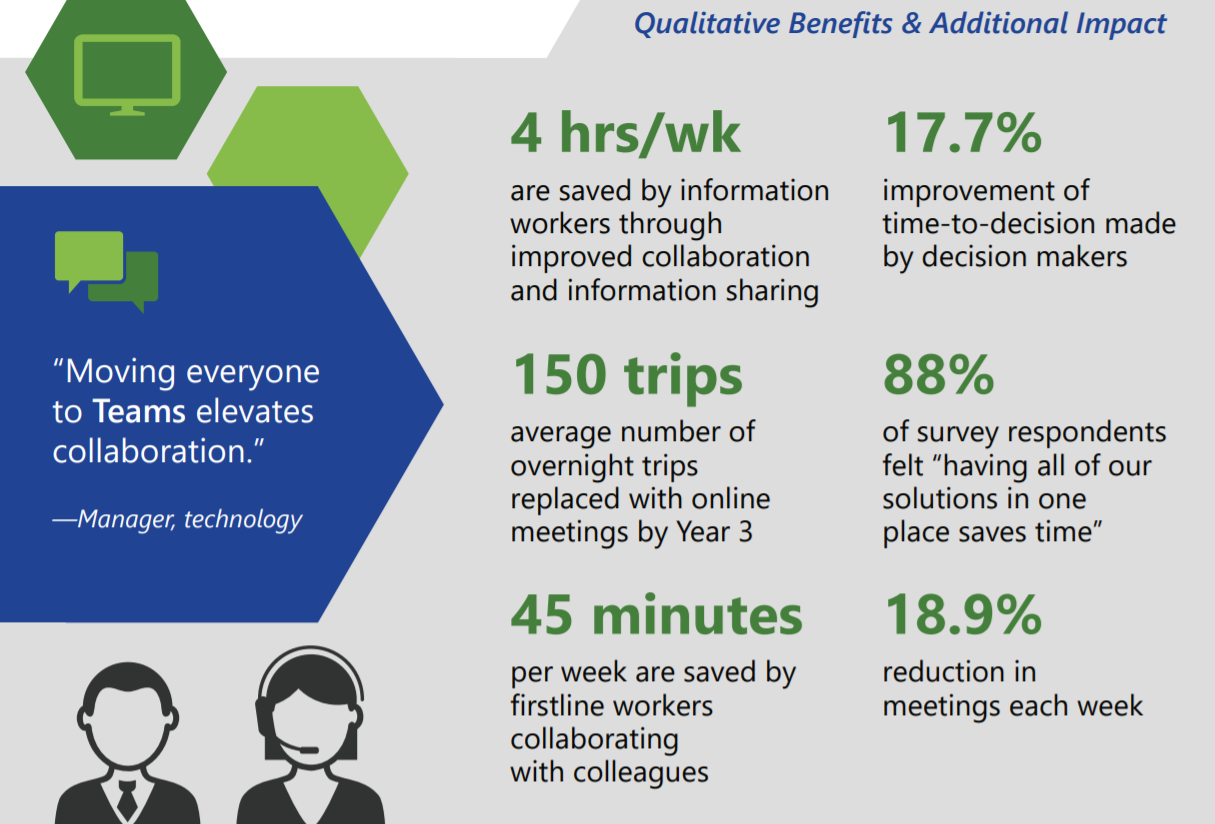
Quantifying the value of collaboration with Microsoft Teams
In today’s global work environment, organizations and their employees must effectively communicate across different locations, time zones, and languages to drive their businesses forward. Microsoft Teams puts everything organizations need—chats, meetings, calling, and Office 365 apps—to make faster, more informed decisions in a single, intelligent hub. With Teams, every type of worker—from the Firstline Worker to the C-suite—is empowered to contribute their voice and take shared accountability for business outcomes.
To quantify the benefits of Teams for organizations and employees, Forrester Consulting conducted a Total Economic Impact™ study of Microsoft Teams, commissioned by Microsoft. Forrester interviewed and surveyed over 260 customers using Teams in a wide range of industries, spanning financial services to education.
All customers cited the following business objectives for implementing Teams:
- Increase employee productivity.
- Improve collaboration across the organization.
- Enable innovation.
Forrester study: The Total Economic Impact™ Of Microsoft Teams.
The study revealed that by empowering employees with Teams, businesses can reduce the costs of collaboration, accelerate decision-making, and improve the customer and employee experience.
Forrester study: The Total Economic Impact™ Of Microsoft Teams.
Overall, customers were pleased with Teams and how well it integrates with the rest of Office 365. They cited associated cost savings as a key factor in adopting Teams. For a standard 5,000-user organization, the study reported benefits and costs of roughly $30.3 million and $3.3 million respectively, resulting in an overall net benefit of $27.1 million over three years.
“Teams integrates well with the Office 365 suite, which is very important. Our CIO decided that Teams has superior functionality to the other solutions we were considering and integrates better. That will save us money.”
—Forrester study: The Total Economic Impact™ Of Microsoft Teams
“Teams is very positive for engendering a coworking environment. It gives you everything you want in one place to effectively collaborate. You can contact each other quickly and also understand what other people are working on.”
—Forrester study: The Total Economic Impact™ Of Microsoft Teams
Key benefits from implementing Teams
The study uncovered 11 benefits for companies to consider as they evaluate Teams as a primary communication and collaboration tool.
The top four benefits are:
- Teams reduces the total number of meetings and their duration. Online meetings conducted over Teams are reliable and of very high audio-video quality. As a result, employees spend less time addressing setup and call quality issues, and more time interacting. The total time savings equal $6.9 million.
- Information workers save four hours per week from improved collaboration and information sharing. With Teams features like coauthoring, integrated file storage, and internal directory, information workers can effectively and efficiently collaborate in real-time. The potential savings equal more than $14.3 million.
- Information workers save more than one hour per week by not having to switch between applications. Access to third-party and line-of-business apps inside Teams from any device benefits all workers, especially remote workers. This creates better employee cohesion and a common corporate culture across locations. The total savings are nearly $4.8 million.
- Having resources available online in Teams reduces downtime by 14.6 percent. When resources are available in one cloud-based location, downtime is reduced and complexity is lowered, making security and compliance easier. Compared to on-premises solutions, the time savings are worth $258,000 across information and Firstline Workers.
Download the Forrester Total Economic Impact™ Of Microsoft Teams study today and learn more about the measurable impact Teams can have for your organization.






